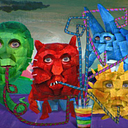This Animated Studio Ghibli film is one of our family’s favourites.
The story seems to revolve around the tension between two opposing worlds.
We are not falling into the western trap of ‘good’ versus ‘evil’ though. This is more like the ‘active principle’ clashing with the ‘passive principle’; Human Industry and progress, pitching up against nature and ecology. We might even dare stretch the analogy a bit and evoke the big one; Consciousness bound together with it’s flip-side, the unconscious.
What’s so refreshing about this movie is that both sides are portrayed sympathetically.
This is more in line with the ‘eastern’ way of thinking, where ‘good’ does not involve just siding with one half of the whole, instead it relates more to a state of harmony and balance between these forces.
In the taiji symbol of yin and yang, each side carries the seed of its opposite within itself.
Princess Mononoke is the active, wild principle embedded in the forest of silent knowledge. And Lady Eboshi is the calm, collected, reflective force at the centre of the active bustle of Iron City.
The third force is a reconciling/ spiritual force; It is the result of the clash between these two opposing forces, and is portrayed by Ashitaka and his journey.
Weapons of war and agricultural tools made of iron were the drivers of human civilization in the Muromachi Era. (in which this film was set.)
And it is iron, this symbol of the civilising force, that kills the spirit of the forest; the Deer god.
In the folklore of the northern countries the faerie folk are repelled and can be harmed by ‘cold iron’.
Superstitions still surround the blacksmith. In legends they possess healing abilities and in Scotland, they are traditionally allowed to perform marriages.
The Forest Spirit is the silently unmoving hub around which the story revolves. This is the Deer God (Shishigami) and also the ‘Night-Walker’ (Daidarabotchi)
It is the central mystery; The axis of life and death.
The Deer God does not speak. There is a profound and pregnant silence whenether ‘it’ makes an appearance on the screen. The frames slow, time stands still and the ‘camera’ lingers. It’s face fills the screen and we gaze into those luminous, reflective eyes as it, in turn, looks directly at us. This is a communication that goes far beyond the everyday language we recognise.
When Ashitaka sees the Deer God for the first time, he strains to see him, and yet the Deer God appears to gaze at Ashitaka clearly and directly.
When Eboshi aims her gun sight at the Deer God, he gazes back at her knowingly. He is after all, the god of life and death and is the gatekeeper of the mystery, with the power to heal, save life, and also the power to cause death.
Lady Eboshi shoots the Deer God a second time and he turns his head to look at her. There is a kindness and understanding in ‘his’ gaze and then the god turns slowly to us, the audience. He is asking us to draw our own conclusions on what it is to ‘kill a god.’
If there is darkness in the film it comes from those characters that shrink away from these natural forces of life and death.
Nago was once a boar god. He was slowly corrupted by an iron shot, embedded in his flesh and this coupled with his rage and fear of death transformed him into a Demon God.
Here the boars confront Moro, the Wolf God:
The boars: The Forest Spirit saved him (Ashitaka)? Saved the life of that loathsome runt? Why didn’t he save Nago? Is he not the guardian of the forest? Why?
Moro: The Forest Spirit gives life and takes life away. Life and death are his alone, or have you boars forgotten that?
The boars: You lie! You must have begged the Forest Spirit to spare his life! But you did not beg for Nago, did you?
Moro: Nago was afraid to die. Now I, too, carry within my breast a poisoned human bullet. Nago fled, and the darkness took him. I remain and contemplate my death.
San: Mother! Please ask the Forest Spirit to save you.
Moro: I have lived long enough, San. Soon the Forest Spirit will let me rest forever.
